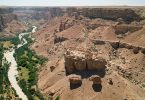Marib
By Tamjid Alkohali
“If wars kill innocent people, how can we take care of archaeological sites?” asked Professor of Antiquities Ahmed Thabet. War and military operations, led by Saudi Arabia, have drawn attention to archaeological sites in Yemen, especially as airstrikes are targeting the military infrastructure in most provinces. There are fears of destroying historical sites, as happened in Libya, Iraq and Syria. The concerned authorities have now appealed to conflicting parties to avoid archaeological sites.
The first appeal was made by the General Authority to Maintain Historic Sites, al-Rzaq Jhaf, through National Yemen newspaper, said archaeological sites are living in danger now more than any other time. “I see through the Saudi Arabia-led airstrikes a deep malice for Yemen and its history and civilization. I expect them to target archaeological sites as they try to prevent Yemen from occupying the international status that it deserves in all life aspects including the cultural dimension.”
As a result of the weakness of the General Authority’s, a note was sent to UNESCO to warn the aggressors and hold them internationally responsible in case sites are damaged, either those registered or not registered on the World Heritage List.
Director General of the Antiquities Office in Taiz Bushra Khulaidi expressed her concern about the archaeological sites, especially after local military forces put anti-aircraft on the Al-Qahira Citadel that rises 1,500 meters above sea level, which may led a bombardment of the Citadel.
“We quickly demanded them to leave the citadel and fortunately they have respond. Until now all archaeological sites remain safe,” Khulaidi added.
Khulaidi explained that Taiz has many castles, forts and historical monuments that are located on the tops of high mountains and date back to thousands of years in addition to al-Gund Mosque, the second oldest mosque built in the Islamic era. “We hope all the archaeological sites will be safe during times of conflict.”
Due to all these appeals, UNESCO called on all parties involved in the conflict in Yemen to avoid targeting the cultural heritage, pointing to three historic sites listed in the World Heritage list. Sana’a dates back before the 11th century: Shibam which is known “the Manhattan of the Desert”, and Zabid in the city of science and preachers .
The Director-General of UNESCO, Irina Bokova said, the heritage of Yemen is unique, reflecting centuries of Islamic thought, rich exchange, and dialogue. “I call on the people of Yemen, as well as countries in the region engaging in military operations in Yemen, to protect Yemen’s invaluable cultural heritage.”
Bokova cautioned all parties from targeting, by shelling or by air strikes, or using for military purposes cultural heritage sites and buildings.
She recalled the obligations under international humanitarian law to protect cultural heritage, in particular the 1954 Hague Convention for the Protection of Cultural Property in the Event of Armed Conflict.
Professor of Antiquities, Ahmed Thabet, spoke more about the ravages of war on historic sites. He said, “Unfortunately, there is no benefit from any appeals now. Conflicted parties realize the value of archaeological sites. However, wars are blind and don’t have a red line for these sites. If wars kill innocent people, how will they take care of the archaeological sites?”
Thabet confirmed that antiquities in Yemen have suffered for a long time and this war has doubled the tragedy. “If the war intensifies, archaeological sites will be destroyed without doubt. Some antiquities in Radaa, Jawf, Marib, and Amran were destroyed in the conflicts of 2011, and these places include 90% of the archaeological inventory in Yemen.”
Fears increased today about Saada province, which is inhabited by the Houthis who are targeted by Saudi airstrikes. “Saada has an unlimited inherited cultural and historical legacy, either in architecture, mosques, Islamic graves, castles, or forts, as well as fertile agricultural lands. All these places were exposed to damage during the six wars between the governmental forces and the Houthis since 2004, and there is a fear of destroying them completely now by Saudi airstrikes.”
The name “Yemen” is linked to the most famous civilizations and kingdoms in the history such as Sheba, Osan, and Himyarite. The Sheba Kingdom, known by its famous Queen Balqees who is mentioned in the holy Qur’an, was based in Yemen and divided into strong states such as Maeen, Qataban and Hadramout. In general, Yemen has many beautiful cities that contain many tourist attractions and attract cultural tourism, historical tourism and natural tourism.



